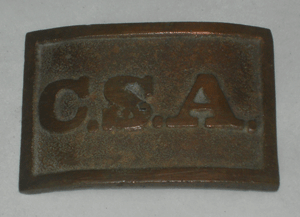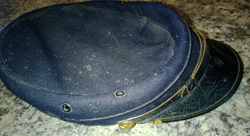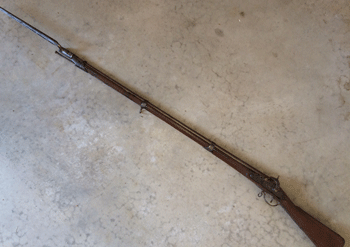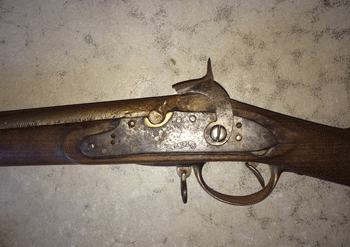|

|

Posted December 2015

|
If you have a Civil War item that you can't identify or something you want to know the value of, contact John (mail: Box 510, Acworth, GA 30101;
email John at seantiquing@go-star.com with
Civil War in the subject
line or call 770-329-4984 or 770-974-6495). John needs a good description of the item, condition, manufacturer's marks and any other markings, and photos.
Please Note: All questions MUST be accompanied with a Photo, it should not be more than 200k in file size.
|
|
|
|
I am the curator of a small GAR museum in Aurora, Il., and have inherited over the years a mish-mash collection of military artifacts collected by veterans’ groups. I have virtually no provenance to work from with most of the artifacts. I have a couple in my collection that will be very valuable for education and display if they are authentic, but it is equally possible that they are reproductions.
I found your information while researching a CSA belt plate. I hope you might be able to help me authenticate this belt plate that is 1 7/8 x 2 5/8 inches. It has a slight curve to it. There are three belt hooks on the back, which have marks on them consistent with hand-hammering. There is a casting error in the center of the “S” resulting in a small hole that goes clear through the center of the plate.
 I would very much appreciate any help you could give me in authenticating this artifact. I don’t want to display it to the public in error as a period-authentic piece if that is not the case. Thank you so much for your time. I would very much appreciate any help you could give me in authenticating this artifact. I don’t want to display it to the public in error as a period-authentic piece if that is not the case. Thank you so much for your time.
JS: Your buckle appears to be an original Confederate enlisted belt plate made in Atlanta. These plates were issued to Army of Tennessee troops under General Joe Johnston while in winter camp around Dalton, Ga., in early 1864 before the Atlanta campaign unfolded. These buckles are excavated by relic hunters in areas occupied by this army. Non-dug examples are scarcer and bring some premium if they have a fine patina, as this example appears to have. Excavated examples typically sell for $2,000-$3,000; this specimen would bring $3,500 or so in the Civil War collector's market.
|
|
|
 Hello
- found your site on the internet and was hopeful you may be able to tell me if this kepi is from the Civil War. If not what timeframe it’s from and value? Inside the hat on liner: “Army Standard B. Pasquale Co Inc. 223 Sutter St. San Francisco, Cal.” Thanks a lot! Much appreciated. Hello
- found your site on the internet and was hopeful you may be able to tell me if this kepi is from the Civil War. If not what timeframe it’s from and value? Inside the hat on liner: “Army Standard B. Pasquale Co Inc. 223 Sutter St. San Francisco, Cal.” Thanks a lot! Much appreciated.
JS: Your kepi dates to about 1890. Pasquale was a well-known San Francisco military and fraternal regalia dealer in late 19th century and well into 20th century. They sold everything, swords, uniforms and accessories that the well-dressed militia officer would need. Similar militia headgear is generally priced around $50-$100 at antique shows.
|
|
|
John, wondering what this musket is worth. It is in good condition with all parts intact.
JS: Your musket started out life as a flintlock, later converted to percussion, probably about 1850 or just prior to the Civil War. The marking "NEW HAVEN" on the lock plate denotes the musket was originally made by Eli Whitney of New Haven, Ct., about 1812. The model is most often known in the literature as model 1808. There were many different conversions from flint to percussion; some performed by arsenals and others by blacksmiths, gunsmiths or any other competent mechanic who could make the gun "more modern" for percussion-cap ignition.
|

|

|
The lines of the hammer are unusual, and almost have a folk art appeal along with the layered brass/copper bolster. Your gun does appear complete including the ramrod, which is often missing. There could be other proofs stamped on the barrel which might tell you which state originally purchased this gun (often “SNY” for New York or “S.C.” for State of Connecticut) as most Whitneys in this configuration are state militia purchases and not U.S. government contracts.
Regardless of state markings or not, you can find similar guns priced at antique arms shows for an average price of probably of $1,200 or so. Percussion-conversion muskets are quite common to the market and generally sell at auction in fine condition between $600 and $800; however, most of these are later 1820s-1840s original manufacture. An American musket that could have seen the War of 1812 should probably bring a premium.
|
|
|
I am contacting you regarding two Confederate states loan certificates that I recently found. These items are not the bond documents which have coupons attached, but rather they have different amounts written in (one is $400 and one is $1,000), and they indicate that the loans paid 8% per year over a five- or 10-year period. They are dated 1862 and 1863. I have found very many similar documents that have the coupons and preprinted amounts, but I have been unable to locate many like these. The Virginia historical society does have an image on their site which shows one very much like these I have. I am interested in obtaining an initial assessment of whether these items carry much potential value.
JS: Your two "loan certificates" are better known as Confederate bonds. There are several reference books that break them down into many subtypes. The original 1961 reference on the subject is by Grover Criswell, Confederate and Southern States Bonds; his reference numbers are most commonly used, though there are more recent publications.
As you noted, many bonds had coupons that were clipped when interest was due. This type of bond is noted by Criswell as a stock certificate. There are four different borders known on your $400 certificate vignette of a sailing ship. This is referenced by Criswell as CR106 from a total of 175 different types. There were 13,284 of this particular stock certificate issued in varying amounts. This certificate was printed by Hoyer & Ludwig in Richmond, VA. The other versions of this particular bond were published by J.T. Patterson & Co., Columbia, S.C.
Your other stock certificate (CR126) with the vignette of a reclining figure with charts and globe is a labor issue, as you can see in the right hand border stating it was from the Confederate Treasury Act of February 20, 1863. This particular certificate was printed by Evans & Cogswell, Columbia, S.C. There were 6,381 of this certificate issued. Both of your certificates appear in good overall condition, though the CR106 appears to be cracked at several folds with soiling and damage to edges. It will sell for less than the CR126. These certificates are among the most common of Confederate Bonds; their retail values are between $100 and $200 each.
|
|
|
John Sexton is an independent appraiser and expert of Civil War memorabilia. He is an accredited member of various appraiser organizations. He can be contacted at 770-329-4984 or www.CivilWarDealer.com. If you have a Civil War item for him to appraise, email a photo and a description to seantiquing@go-star.com
.
|
|
|
|
|
|
|
|